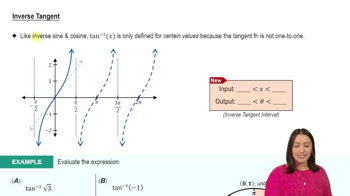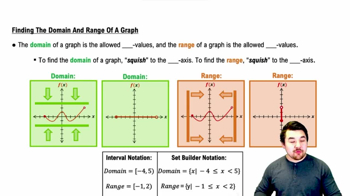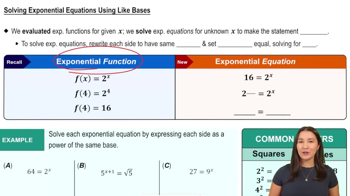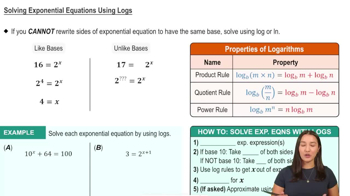Table of contents
- 0. Functions7h 52m
- Introduction to Functions16m
- Piecewise Functions10m
- Properties of Functions9m
- Common Functions1h 8m
- Transformations5m
- Combining Functions27m
- Exponent rules32m
- Exponential Functions28m
- Logarithmic Functions24m
- Properties of Logarithms34m
- Exponential & Logarithmic Equations35m
- Introduction to Trigonometric Functions38m
- Graphs of Trigonometric Functions44m
- Trigonometric Identities47m
- Inverse Trigonometric Functions48m
- 1. Limits and Continuity2h 2m
- 2. Intro to Derivatives1h 33m
- 3. Techniques of Differentiation3h 18m
- 4. Applications of Derivatives2h 38m
- 5. Graphical Applications of Derivatives6h 2m
- 6. Derivatives of Inverse, Exponential, & Logarithmic Functions2h 37m
- 7. Antiderivatives & Indefinite Integrals1h 26m
- 8. Definite Integrals4h 44m
- 9. Graphical Applications of Integrals2h 27m
- 10. Physics Applications of Integrals 2h 22m
0. Functions
Exponential & Logarithmic Equations
Problem 1.11
Textbook Question
Sketch the graph of the inverse of ƒ. <IMAGE>
 Verified step by step guidance
Verified step by step guidance1
Step 1: Understand the concept of an inverse function. The inverse of a function \( f \), denoted as \( f^{-1} \), is a function that 'reverses' the effect of \( f \). For a function to have an inverse, it must be one-to-one (bijective).
Step 2: Identify the domain and range of the original function \( f \). The domain of \( f \) becomes the range of \( f^{-1} \), and the range of \( f \) becomes the domain of \( f^{-1} \).
Step 3: Reflect the graph of \( f \) across the line \( y = x \). This reflection will give you the graph of \( f^{-1} \). Each point \((a, b)\) on the graph of \( f \) corresponds to a point \((b, a)\) on the graph of \( f^{-1} \).
Step 4: Verify that the reflected graph is a function. Ensure that the graph of \( f^{-1} \) passes the vertical line test, which confirms that it is a valid function.
Step 5: Label the axes and key points on the graph of \( f^{-1} \) to clearly indicate the transformation from the original function \( f \).
 Verified video answer for a similar problem:
Verified video answer for a similar problem:This video solution was recommended by our tutors as helpful for the problem above
Video duration:
5mPlay a video:
Was this helpful?
Key Concepts
Here are the essential concepts you must grasp in order to answer the question correctly.
Inverse Functions
An inverse function essentially reverses the effect of the original function. If a function f takes an input x and produces an output y, the inverse function f⁻¹ takes y as input and returns x. For a function to have an inverse, it must be one-to-one, meaning each output is produced by exactly one input.
Recommended video:

Inverse Cosine
Graphing Functions and Their Inverses
When graphing a function and its inverse, a key property is that the graphs are reflections of each other across the line y = x. This means that if a point (a, b) lies on the graph of f, then the point (b, a) will lie on the graph of f⁻¹. Understanding this relationship is crucial for accurately sketching the inverse graph.
Recommended video:

Inverse Tangent
Domain and Range
The domain of a function is the set of all possible input values, while the range is the set of all possible output values. For inverse functions, the domain of the original function becomes the range of the inverse function and vice versa. Recognizing how to switch these sets is essential for correctly sketching the graph of an inverse function.
Recommended video:

Finding the Domain and Range of a Graph

 4:46m
4:46mWatch next
Master Solving Exponential Equations Using Like Bases with a bite sized video explanation from Callie
Start learningRelated Videos
Related Practice




